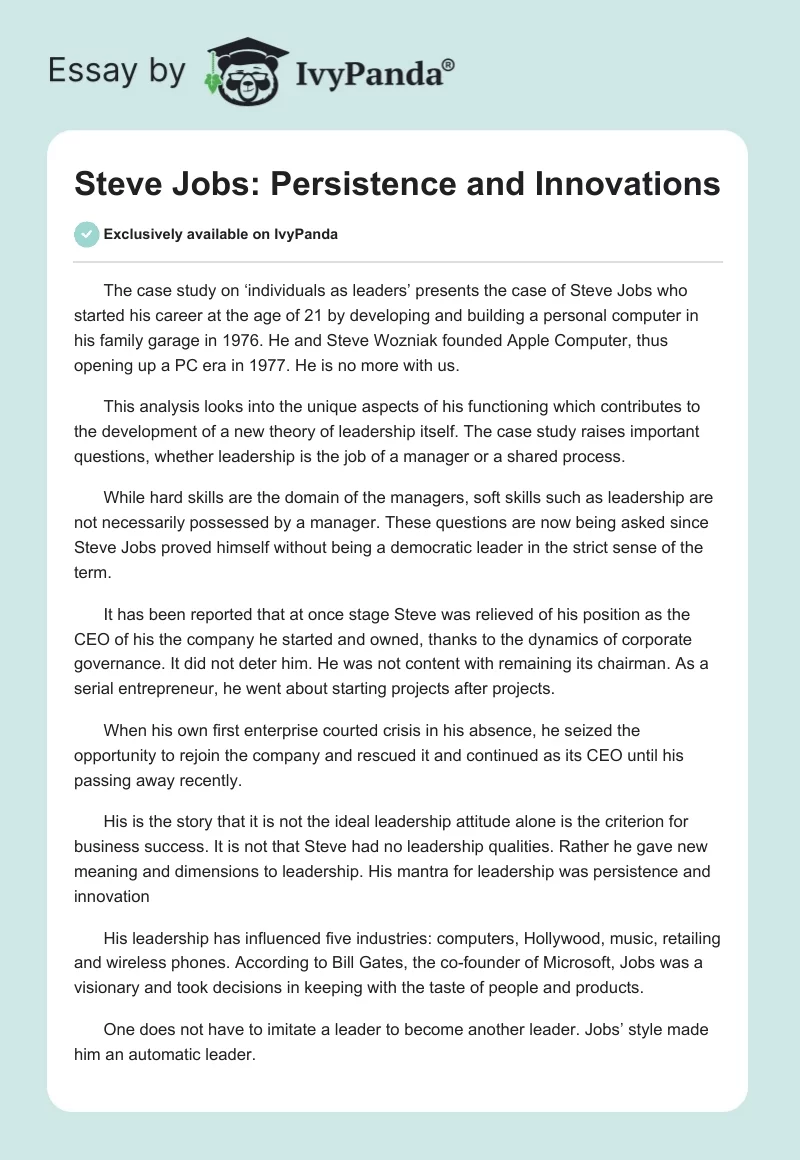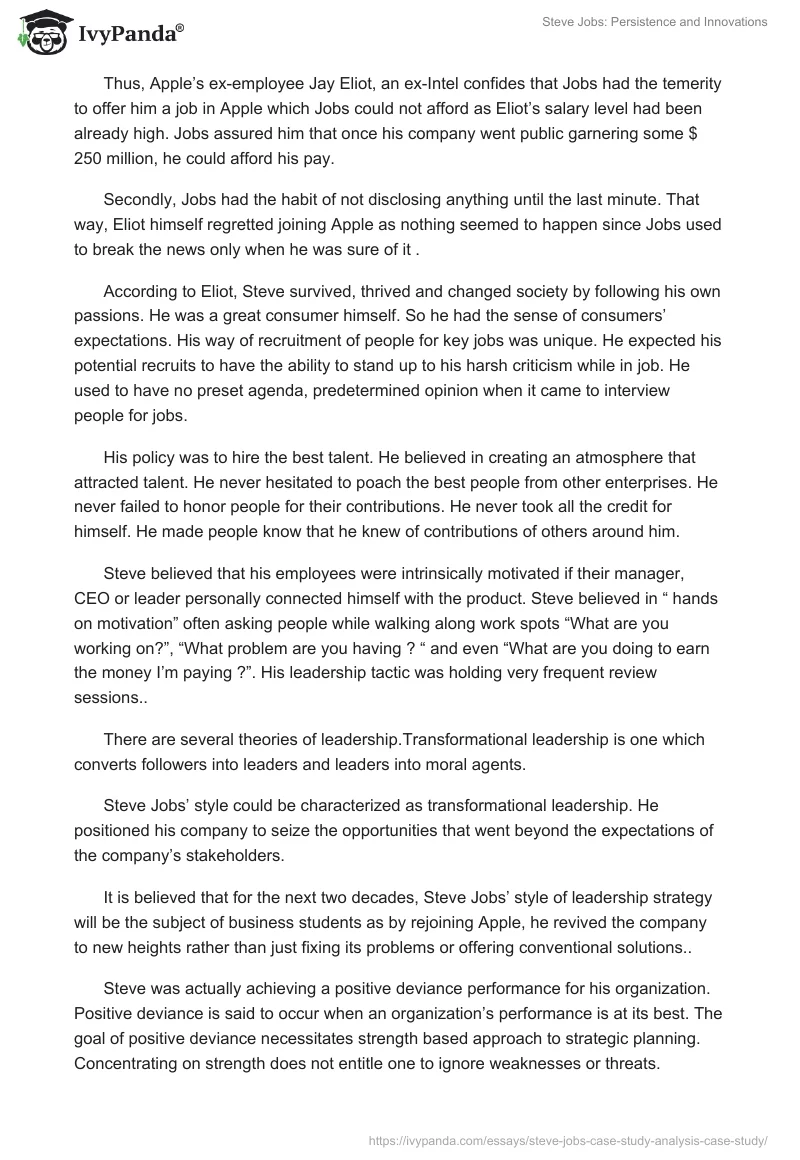The case study on ‘individuals as leaders’ presents the case of Steve Jobs who started his career at the age of 21 by developing and building a personal computer in his family garage in 1976. He and Steve Wozniak founded Apple Computer, thus opening up a PC era in 1977. He is no more with us.
This analysis looks into the unique aspects of his functioning which contributes to the development of a new theory of leadership itself. The case study raises important questions, whether leadership is the job of a manager or a shared process.
While hard skills are the domain of the managers, soft skills such as leadership are not necessarily possessed by a manager. These questions are now being asked since Steve Jobs proved himself without being a democratic leader in the strict sense of the term.
It has been reported that at once stage Steve was relieved of his position as the CEO of his the company he started and owned, thanks to the dynamics of corporate governance. It did not deter him. He was not content with remaining its chairman. As a serial entrepreneur, he went about starting projects after projects.
When his own first enterprise courted crisis in his absence, he seized the opportunity to rejoin the company and rescued it and continued as its CEO until his passing away recently.
His is the story that it is not the ideal leadership attitude alone is the criterion for business success. It is not that Steve had no leadership qualities. Rather he gave new meaning and dimensions to leadership. His mantra for leadership was persistence and innovation
His leadership has influenced five industries: computers, Hollywood, music, retailing and wireless phones. According to Bill Gates, the co-founder of Microsoft, Jobs was a visionary and took decisions in keeping with the taste of people and products.
One does not have to imitate a leader to become another leader. Jobs’ style made him an automatic leader.
Thus, Apple’s ex-employee Jay Eliot, an ex-Intel confides that Jobs had the temerity to offer him a job in Apple which Jobs could not afford as Eliot’s salary level had been already high. Jobs assured him that once his company went public garnering some $ 250 million, he could afford his pay.
Secondly, Jobs had the habit of not disclosing anything until the last minute. That way, Eliot himself regretted joining Apple as nothing seemed to happen since Jobs used to break the news only when he was sure of it .
According to Eliot, Steve survived, thrived and changed society by following his own passions. He was a great consumer himself. So he had the sense of consumers’ expectations. His way of recruitment of people for key jobs was unique. He expected his potential recruits to have the ability to stand up to his harsh criticism while in job. He used to have no preset agenda, predetermined opinion when it came to interview people for jobs.
His policy was to hire the best talent. He believed in creating an atmosphere that attracted talent. He never hesitated to poach the best people from other enterprises. He never failed to honor people for their contributions. He never took all the credit for himself. He made people know that he knew of contributions of others around him.
Steve believed that his employees were intrinsically motivated if their manager, CEO or leader personally connected himself with the product. Steve believed in “ hands on motivation” often asking people while walking along work spots “What are you working on?”, “What problem are you having ? “ and even “What are you doing to earn the money I’m paying ?”. His leadership tactic was holding very frequent review sessions..
There are several theories of leadership.Transformational leadership is one which converts followers into leaders and leaders into moral agents.
Steve Jobs’ style could be characterized as transformational leadership. He positioned his company to seize the opportunities that went beyond the expectations of the company’s stakeholders.
It is believed that for the next two decades, Steve Jobs’ style of leadership strategy will be the subject of business students as by rejoining Apple, he revived the company to new heights rather than just fixing its problems or offering conventional solutions..
Steve was actually achieving a positive deviance performance for his organization. Positive deviance is said to occur when an organization’s performance is at its best. The goal of positive deviance necessitates strength based approach to strategic planning. Concentrating on strength does not entitle one to ignore weaknesses or threats.
The organizational members are empowered to understand firm’s core capabilities that can potentially sustain a positive deviant performance. Steve Jobs achieved this as the CEO from $ 5 billion when he returned to Apple to $ 170 billion within a decade. Apple’s success was not only on the financial front but also in the others. Its market share in the US for MP3 player market was 73 %.
It was 11 % in smart phone market worldwide. Apple has already won awards of innovation, marketing and management. One of Job’s tactics was strategic story telling which motivated his employees and stakeholders. He proved that a leader should seize opportunities. He made apple a learning organization.
References
Anoymous. (n.d.). Steve Jobs: Leadership Case Study. Leadership With You Web.
Bolden, R., Gosling, J., Marturano, A., & Dennison, P. (2003). A Review Of Leadership Theory And Competency Frameworks. Centre for Leadership Studies, University of Exeter, United KIngdom.
Burns, J. (1978). Leadership. New York: Harper & Row.
Elliot, J., & Simon, W. L. (2011). The Steve Jobs’ Way : Ileadership for a New Generation. New York: Vanguard.
Wooten, P. L. (n.d.). Building a company the Steve Job’s Way: A positive Deviance Approach to Strategy. Ross School of Business, University of MIchigan.


